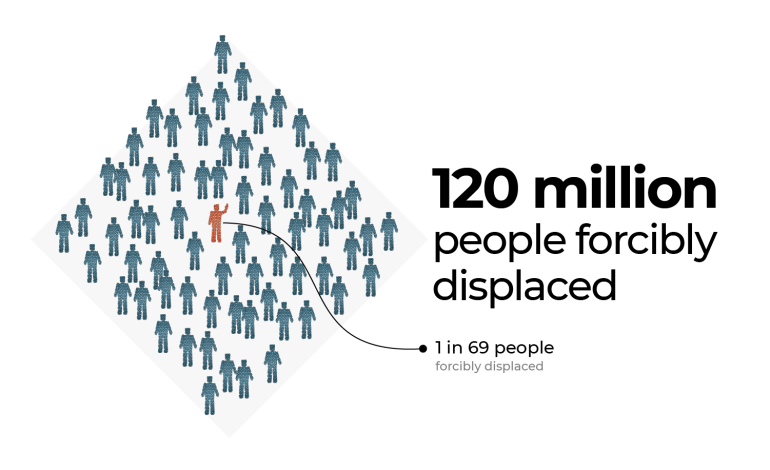Forcibly displaced population doubles to 120 million over the past 10 years

At least 117.3 million people, or one in 69 individuals worldwide, remain forcibly displaced, according to a report released by the United Nations High Commissioner for Refugees (UNHCR) today.
Forced displacement as a result of conflict and violence, persecution and human rights violations, has continued to rise in the first four months of 2024 and is likely to have surpassed 120 million by the end of April 2024.
Of the 117.3 million forcibly displaced, 68.3 million are internally displaced within their own countries due to conflict or other crises, such as Gaza where the UN estimates about 75 percent of the population, or more than 1.7 million people have been displaced by Israel’s continuing assault.
The number of refugees who crossed international borders, in 2023 rose by seven percent to 43.4 million. The increase is driven by displacement in Sudan and ongoing conflicts in Ukraine and other regions.
The number of asylum seekers – people seeking protection in another country due to persecution or fear of harm in their home country – waiting for a decision stood at 6.9 million, an increase of 26 percent from the previous year.
The rise of refugees and displaced people
In 1951, the UN established the Refugee Convention to protect the rights of refugees in Europe in the aftermath of World War II. In 1967, the convention was expanded to address displacement across the rest of the world.
When the Refugee Convention was born, there were 2.1 million refugees. By 1980, the number of refugees recorded by the UN surpassed 10 million for the first time. Wars in Afghanistan and Ethiopia during the 1980s caused the number of refugees to double to 20 million by 1990.
However, the United States invasion of Afghanistan in 2001 and Iraq in 2003, together with the civil wars in South Sudan and Syria, resulted in refugee numbers exceeding 30 million by the end of 2021.
The war in Ukraine, which started in 2022, led to one of the fastest growing refugee crises since World War II with 5.7 million people forced to flee Ukraine in less than a year. By the end of 2023, six million Ukrainians remained forcibly displaced.
In 2023, conflict in Sudan between the Sudanese army and the Rapid Support Forces increased the number of refugees to 1.5 million. Before the war, Sudan hosted many Syrian refugees. When the war started, the number of Syrian refugees in Sudan dropped from 93,500 in 2022 to 26,600 in 2023, as many left for other countries. Thousands of people are still being displaced daily, more than a year after the conflict began.
Most recently, Israel’s bombardment of the Gaza Strip has had a devastating toll on the Palestinian population. The UNRWA estimates that between October and December 2023, up to 1.7 million people – more than 75 percent of the population- have been displaced within the Gaza Strip, with many having been forced to flee multiple times.
The humanitarian situation in the Gaza Strip is extremely dire, with all 2.3 million inhabitants facing food insecurity and the threat of famine.
Where are refugees coming from?
Almost three-quarters (72 percent) of all refugees came from just five countries: Afghanistan (6.4 million), Syria (6.4 million), Venezuela (6.1 million), Ukraine (6 million) and Palestine (6 million).
Under international law, refugees are people who are forced to flee their home countries to escape persecution or a serious threat to their life, physical integrity or freedom.
Who hosts the most refugees?
Almost 70 percent of refugees and others in need of international protection lived in countries neighbouring their countries of origin.
Globally, the largest refugee populations are hosted by Iran (3.8 million), Turkey (3.3 million), Colombia (2.9 million), Germany (2.6 million) and Pakistan (2 million).
Nearly all refugees in Iran and Pakistan are Afghans, while most refugees in Turkey are Syrians.
In the last decade, refugee numbers have increased in these major host countries, except for Turkey, where numbers have dropped by 14 percent since 2021.
Germany is the only major host country that does not border the main refugee source countries. Most refugees in Germany at the end of the year were from Ukraine (1.1 million), Syria (705,800), Afghanistan (255,100), and Iraq (146,500).










